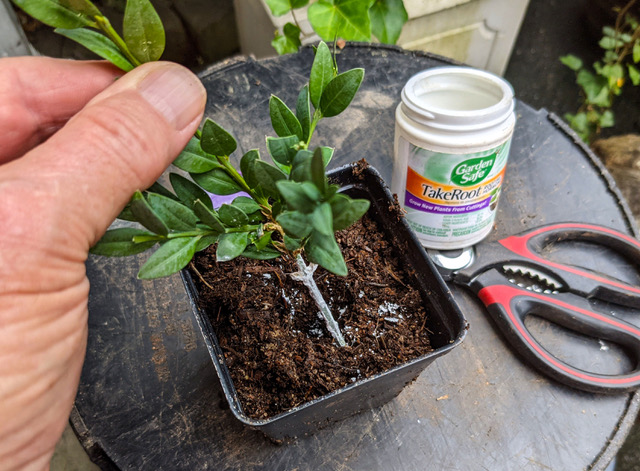
Now is an ideal time to propagate garden plants, especially woody types. Propagation is easy with the right steps, a few supplies and simple tools.
There are two ways to reliably increase garden plants, either by root divisions or by cuttings taken at just the right time and rooted in a growing medium.
The best way to get a lot of new plants from a shrub is to take cuttings of new growth just as it has hardened off in late spring to early summer. For the Cape Region, that means anytime from mid-June to mid-July. Cuttings should be from 5 to 8 inches long and should have branching above the cut. Lower leaves and leaf nodes on the cuttings should be plucked off. The branching tips of the cuttings should be cut back about halfway with half as many leaves left on them. Then dip the stripped cut end about 3 inches into rooting hormone powder, available in all garden stores and most box stores with garden centers. The powder should coat the stem, and especially all plucked leaf nodes or side stem nodes from which roots are most likely to emerge.
Fill a 4- or 6-inch-diameter pot with quality potting soil mixed with good compost. Poke a hole in the middle and insert the powdered end of the cutting deep enough to cover the powdered leaf nodes. Then press the soil moderately firmly around the cutting stem and water immediately. Keep the potted plant watered daily in filtered sunlight for four to six weeks, then remove the cutting plant to see if it has good roots started. If it does, it can be planted in the garden or transplanted to a larger pot to prevent drying out and give more rooting room.
Some soft herbaceous plants are easy to propagate as cuttings prepared the same way and put directly into prepared garden soil. Coleus work very well for this method, but must be kept watered a couple times daily for the first week to ensure enough roots to survive. Many herbaceous plants that spread via runners, like strawberries, saxifrage, tradescantia, and many others, will grow roots easily at any node in contact with soil. Those baby plants can be cut off with their roots and transplanted elsewhere as desired.
To grow a new tree, one can root a twig, but it does require patience. Trees are often slower than shrubs to root. This simple method of propagation works for deciduous and evergreen varieties of trees. Terminal branch or twig cuttings become a complete, new plant identical to the parent plant. Branches less than one year old work best for growing trees, so use a cutting from the current year's growth when it is beginning to transform from soft to harder tissue in August or September. Cuttings can work better than growing some species of trees from seed, with root development in a few months and much quicker maturity.
Root divisions are useful for getting new plants from perennials and some shrubs. The best time to divide a perennial is just before new growth starts or shortly thereafter. April is the best time to divide roots in the Cape Region. To divide a multi-stemmed perennial, cut down vertically through the root mass to create a few sections big enough to survive, with at least several stems each. Transplant the divisions immediately to another garden location or into a pot with compost. A big old garden knife works fine for small root balls, and an old saw will work for bigger, tougher root balls.
For shrubs, one can pin a stem to the ground for a year until it develops roots, then cut it free and transplant. It is best to scarify or scratch the stem bark where it will contact the ground, a few weeks before pinning it down. Roots grow more quickly from plant scar tissue, and applying white rooting hormone powder to the scratched stem will also help promote quicker root development. Use a galvanized landscaper’s pin from 6 to 10 inches long, or use a heavy rock to hold the branch firmly to the soil.
Most important for all these methods of propagation is to not let the potted cutting dry out! One way to prevent this is to place the potted cutting, after watering and draining, in a large clear-plastic bag and tie the top. The bag becomes a greenhouse and traps moisture. Open it at least once weekly to help prevent fungal growth, and water whenever the soil feels a bit dry. The bag should only be used for about four weeks or until the plant shows roots coming out the bottom of the pot.
Growing your own garden plants and sharing plants with other gardeners is an old tradition. If you are new to propagating your own plants, enjoy giving it a try.
"easy" - Google News
June 28, 2021 at 10:31PM
https://ift.tt/3qF41vS
Easy ways to propagate woody shrubs and perennials - CapeGazette.com
"easy" - Google News
https://ift.tt/38z63U6
Shoes Man Tutorial
Pos News Update
Meme Update
Korean Entertainment News
Japan News Update
Bagikan Berita Ini














0 Response to "Easy ways to propagate woody shrubs and perennials - CapeGazette.com"
Post a Comment